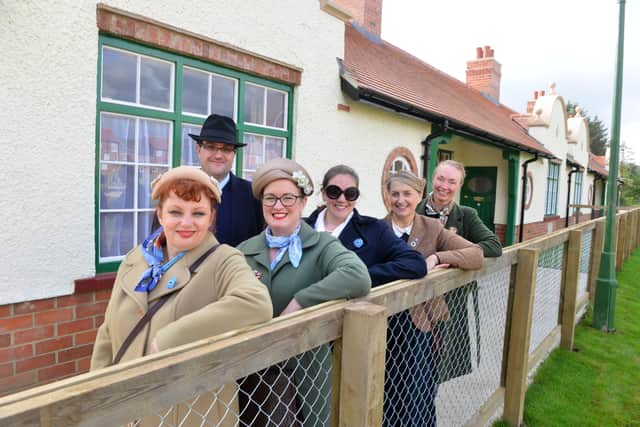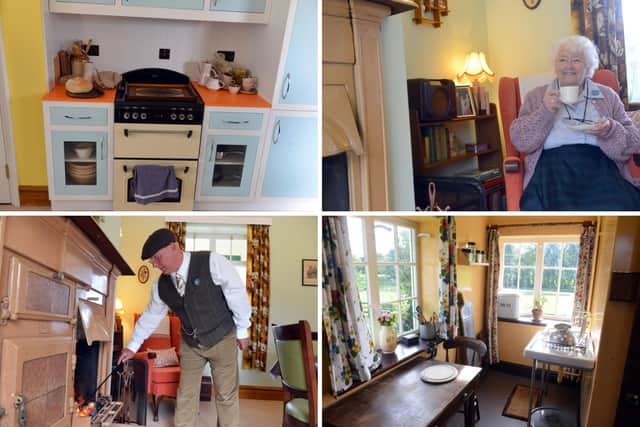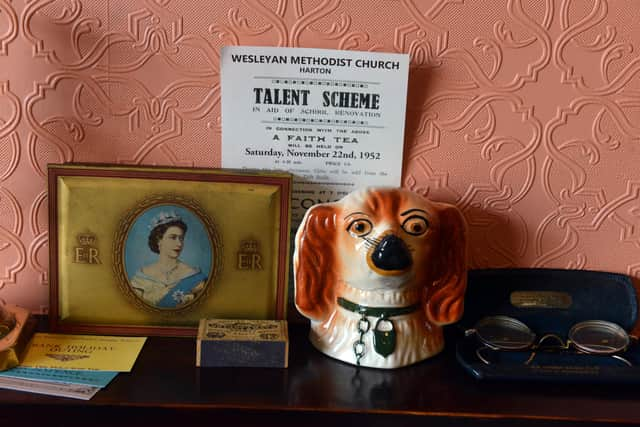Sneak peek around the latest addition to Beamish Museum's 1950s town
and live on Freeview channel 276
Stepping into the 1950s retired miners' cottages in Beamish had a strangely familiar feel, in keeping with the museum’s fundamental principle of bringing living history to life.
Currently in my forties, the 1950s was considerably before my time, but the period represented the childhood of my parents and the working adulthood of my grandparents and great aunts and uncles.
Advertisement
Hide AdAdvertisement
Hide AdWhether it be the dressing table in the back bedroom with its lattice work decorated mirror, the large teak wardrobe, or the cake tin in the kitchen, it was like walking into my grandmother’s home as a small child in the early 1980s.
Much of the furnishings and ornaments dating back to an era when Elvis was king inevitably still adorned the houses of my older relatives some 20 or 30 years later.
While a little unnerving that a museum setting should feel so familiar there was also a certain warmth in rekindling memories of my childhood and, sadly,some of my long lost relatives.
The new addition to the rapidly evolving 1950s town are three terrace Aged Miners' Homes replicated from Marsden Road in South Shields.


Advertisement
Hide AdAdvertisement
Hide AdHead of Industry at the museum, Jonathan Kindlysides, said: “These cottages were originally built by the Durham Aged Mineworkers’ Homes Association (DAMHA) which was a revolutionary organisation at the time and was one of the earliest forms of social housing.
“At a time when miners relied on their job for a house, if they had to retire through ill health or age they lost their home.
“The DAMHA was then needed to provide housing for these retired miners and that's why these cottages were built in Marsden as they were across the North East.”
We all have relatives who were alive in the 50s, which perhaps makes it feel as though it's an era not yet consigned to history.


Advertisement
Hide AdAdvertisement
Hide AdYet a sneak peek in these cottages highlights just how times have changed in the last seven decades.
There were no signs of any fridges, with food produce still being stored in a pantry, while the weighing scales and other baking utensils highlighted a time when families would make cakes, scones and bread from scratch, rather than buying ready-made products from the supermarket.
While one cottage did have a box TV, this was certainly a luxury most working class families in the 50s couldn’t afford and the radio, record players and piano on display in the other two homes gave an insight into how our parents or grandparents may have entertained themselves at this time.
The original cottages can still be found in Marsden Road and the present residents, along with predecessors who are still alive, were consulted in depth ahead of the Beamish recreation.


Advertisement
Hide AdAdvertisement
Hide AdDAMHA CEO, Paul Mullis, said: “We are delighted to have been involved in this amazing project.
“Our residents at Marsden Road were fully involved from the initial inception, and having visited the completed homes recently, they commented about how sympathetically they have been recreated both inside and out.”
The latest instalment in the 1950s town will be open to the public from 11am on Friday October 6.
Beamish CEO, Rhiannon Hiles said: “This is very special for the museum and a really exciting development for us in the next stage in our Remaking Beamish 1950s town.
Advertisement
Hide AdAdvertisement
Hide Ad“These are beautiful cottages which we were able to replicate from original plans. The museum is constantly developing and to get these cottages open has been a big task, but it’s phenomenal to see them as they are today.”
The cottages are the latest instalment in the Remaking Beamish project, the biggest development in the museum’s 53-year history, to create a 1950s town to enable the museum to remain in keeping with its living history principle.
The ongoing development has already seen the recreation of Leasingthorne Colliery Welfare Hall and Community Centre, Billingham Bowling Green and pavilion, a 1950s park, a pair of police houses from Heworth, and pair of period semi-detached houses from Red House in Sunderland.
A 1950s high street has also been created featuring John's Cafe from Wingate, a replica of the home of Spennymoor artist Norman Cornish, and a recreation of Elizabeth’s Hairdresser’s which was located on Bow Street in Middlesbrough.
Advertisement
Hide AdAdvertisement
Hide AdIf you get peckish you can always enjoy some traditionally cooked fish and chips from the replica chip shop which was located in Middleton St George, near Darlington.
Ongoing construction could also be seen for the recreation of The Grand Cinema, the picture house once of Ryhope which used to be packed out with people looking to watch the latest release from the Golden Age of Hollywood.
The Remaking Beamish project was awarded £10.9million by The National Lottery Heritage Fund in 2016.
Comment Guidelines
National World encourages reader discussion on our stories. User feedback, insights and back-and-forth exchanges add a rich layer of context to reporting. Please review our Community Guidelines before commenting.